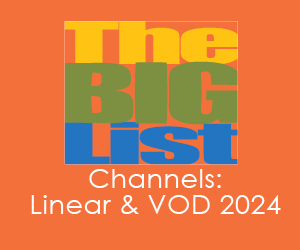
Mobile streaming platform Oona went live on Telkom Indonesia this year with a wide-ranging bundle of free channels/curated playlists, total usage/data transparency for content partners,a revenue-share proposition and points-based incentives to view commercials, and a simpleuser-friendly interface. This is, the platform thinks, “the future of free-to-air TV on mobile”.Head of content partnerships, Dominique Ullman, talks about a new way of gathering, curatingand presenting programming.
Five weeks into Oona’s launch in Indonesia, platform founder Christophe Hochart was at the Mipcom content market in Cannes talking about what he’s doing – “I compete with piracy using free content, free data and the opportunity to win prizes” – and counting his gains: 1.3 million registered users, soaring daily/monthly unique users, 18 minutes average viewing time per session, clicking on an average eight 30-second ads to win points/coins, 700 merchants participating in a advertising/incentive scheme, a new deal for airport/passenger access with free wi-fi, and plans to raise funds by the end of this year to accelerate growth.
Hochart is angling for landings beyond Indonesia, leveraging the learnings and the content partnerships forged in his maiden market. Mexico is on the radar, along with the Philippines, India, China... 85% of content will remain the same regardless of where the service goes, he says. The other 15% will be local. A majority of local operations will be held by a domestic partner, while Hochart will retain full ownership of Oona’s IP and tech.
A few weeks earlier, Oona’s content partnerships head, Dominique Ullman, spoke at the ContentAsia Summit in Singapore about curating content for mobile audiences in Indonesia. The job, he told delegates, was less about his involvement in choosing what goes onto the platform than about connecting customers and content in an ecosystem that also works for telcos and media/agencies/advertisers.
Oona doesn’t see itself as a third party, standing between users and product. In fact, Ullman says, “we don’t want to be a third party”.
What does he want? “We want to provide technology, an application that enables content providers to connect directly with their users.” With full contro...
Mobile streaming platform Oona went live on Telkom Indonesia this year with a wide-ranging bundle of free channels/curated playlists, total usage/data transparency for content partners,a revenue-share proposition and points-based incentives to view commercials, and a simpleuser-friendly interface. This is, the platform thinks, “the future of free-to-air TV on mobile”.Head of content partnerships, Dominique Ullman, talks about a new way of gathering, curatingand presenting programming.
Five weeks into Oona’s launch in Indonesia, platform founder Christophe Hochart was at the Mipcom content market in Cannes talking about what he’s doing – “I compete with piracy using free content, free data and the opportunity to win prizes” – and counting his gains: 1.3 million registered users, soaring daily/monthly unique users, 18 minutes average viewing time per session, clicking on an average eight 30-second ads to win points/coins, 700 merchants participating in a advertising/incentive scheme, a new deal for airport/passenger access with free wi-fi, and plans to raise funds by the end of this year to accelerate growth.
Hochart is angling for landings beyond Indonesia, leveraging the learnings and the content partnerships forged in his maiden market. Mexico is on the radar, along with the Philippines, India, China... 85% of content will remain the same regardless of where the service goes, he says. The other 15% will be local. A majority of local operations will be held by a domestic partner, while Hochart will retain full ownership of Oona’s IP and tech.
A few weeks earlier, Oona’s content partnerships head, Dominique Ullman, spoke at the ContentAsia Summit in Singapore about curating content for mobile audiences in Indonesia. The job, he told delegates, was less about his involvement in choosing what goes onto the platform than about connecting customers and content in an ecosystem that also works for telcos and media/agencies/advertisers.
Oona doesn’t see itself as a third party, standing between users and product. In fact, Ullman says, “we don’t want to be a third party”.
What does he want? “We want to provide technology, an application that enables content providers to connect directly with their users.” With full control of what they put up – or take down – and when. This control is driven by high levels of transparency, which give programmers full insight into what’s working and what’s not, with the freedom to switch out shows at will. In other words, there’s none of the current model where channels go through pay-TV operators selling bundles of channels to users, with all the pricing pressure that involves, and then not freely sharing data that allows channels to fine-tune their product.
The revenue piece is critical. Oona is free to consumers and doesn’t pay for content. “We don’t ask people to pay, but someone has to pay somewhere,” Ullman says, adding that the company has engaged in “a lot of discussion” with media agencies and marketers trying to shape a viable revenue model that does not depend on pushing advertising to users. Oona has partnered with GroupM in Indonesia and with SpotX in for mid- and pre-roll advertising.
Ullman reminds me that this is not his first rodeo. “I’ve been in this business for quite a while... users don’t want to have advertising in the middle of their viewing,” he says. The model being tested in Indonesia turns the interaction from push to pull, sweetened by rewards such as product vouchers and discounts. The more users click on the ad thumbnails that appear in the corner of their screens, the more points they earn, and the more rewards they get. “It’s always the users who decide whether they want to watch advertising or not,” Ullman says, adding that the rewards system was developed in response to agencies’ doubts about the wisdom of asking consumers to request commercials.
Oona’s interface supports its low-to-no intervention philosophy. All the channels/playlists are presented in a carousel at the top of the screen. “We’ve put all the channels on the same level, all have the same chance to be discovered by users as they scroll,” Ullman says.
At the end of August this year, Oona had 115 channels, including Outdoor, a bouquet of brands from Omni Channels Asia and its partnership with U.S.-based channels provider TV4 Entertainment, all3media’s lifestyle channel Inside Outside, and a bundle of channels reformatted from YouTube. In other words, newer channels either sidelined by mainstream platforms or not being given the hearing they would like.
Few of the services known and loved from decades in the traditional pay-TV space are on board so far, although there are some ‘best of’ channels with short-form content from high-profile global providers. Freely admitting the difficulty Oona has had in bulking up its big-brand presence, Ullman says he understands the challenges in shifting to a whole new model after so long. “It’s very difficult for them to just change their mindset and change their business model,” he adds. “When we go to them and say, ‘okay guys, now we’re going to give you revenue but only on advertising’, this is completely new for them and they don’t want to upset their other clients. We completely understand that”.
In gathering little-known channel brands for Asia, Ullman says he’s presenting alternatives that Indonesian viewers have never had access to before. “That’s a very good learning path for us because we learned that while we didn’t think that some channels could be so successful, they are. We have one linear channel called Cowboy Channel with movies from the 1950s and 1960s that is in the top 10 in terms of viewership,” he says.
As the platform digs in and data starts flowing, attitudes are slowly softening. “Suddenly they’re seeing that it works, and they’re see their competitors coming in. And they see advertising coming...”
Oona’s content management system gives providers full control of their channel and user data, along with the choice of display, pre-roll or mid-roll advertising, and insights into revenue earned. “They own their dashboard,” Ullman says, “and they can see minute-by-minute what’s working and what isn’t”. – Janine Stein






















